The Influence of Cyclic Loading on the Mechanical Properties of Well Cement
Abstract
:1. Introduction
2. Experimental Method
2.1. Cement Slurry Design
2.2. Experimental Method
3. Experimental Results
3.1. Monotonic Loading Test Analysis
3.2. The Mechanical Properties of Well Cement during Cyclic Loading
3.3. The Mechanical Properties of Well Cement after Cyclic Loading
3.4. Energy Analysis during Cyclic Loading
3.5. Fatigue Failure Model of Well Cement under Alternating Stress
4. Conclusions
- (1)
- The mechanical properties of well cement are significantly influenced by the testing environment. Specifically, increasing the testing temperature from 25 °C to 140 °C reduces the compressive strength and elastic modulus of well cement by 21% and 14%, respectively. However, the confining pressure has almost no effect on the mechanical properties or stress–strain curves of well cement during undrained tests at high temperatures, possibly due to increased pore pressure with increasing confining pressure.
- (2)
- The deformation and mechanical properties of well cement are influenced by the cyclic loading intensity and cycle number. Under HTHP conditions, well cement exhibits more pronounced strain hysteresis and greater plastic strain, which leads to a higher conversion rate of input energy into dissipated energy. The secant modulus of well cement decreases with increasing loading intensity at all test conditions and also decreases with increasing cycle number, especially under ambient testing conditions with high loading intensity.
- (3)
- Samples that can sustain 20 cycles of cyclic loading without failure exhibit similar ultimate compressive strength as the pristine sample not subjected to cyclic loading. However, the elastic modulus of cyclically loaded samples may decrease when the cyclic loading intensity is high.
- (4)
- Well cement has a longer fatigue life when subjected to HTHP testing conditions compared to that tested under ambient conditions. The fatigue life of well cement increases significantly with a decrease in loading intensity and can be predicted based on the plastic strain evolution rate. At 0.6 P loading intensity (60% of ultimate strength), well cement hardly experiences any fatigue damage.
Author Contributions
Funding
Data Availability Statement
Conflicts of Interest
References
- Caa, M.; Cyran, K.; Kowalski, M. Influence of the Anhydrite Interbeds on a Stability of the Storage Caverns in the Mechelinki Salt Deposit (Northern Poland). Arch. Min. Sci. 2018, 63, 1007–1025. [Google Scholar]
- Xie, L.; Zhang, H.; Li, H. Accident Analysis and Risk Identification of Underground Gas Storage Tanks with Exhausted Oil and Gas Reservoirs. Nat. Gas Ind. 2009, 29, 116–119. [Google Scholar]
- Shu, G.; Liu, J.; Feng, F.; Zhang, Y.; Zhou, L.; Chen, H.; Wang, C. Experimental study on failure mechanism of cement sheath in injection production well of gas storage. Drill. Complet. Fluids 2020, 37, 507–511+520. [Google Scholar]
- Pang, X.; Darbe, R.; Ravi, K.; Meyer, C. Low-cycle fatigue of oil well cements in compression. ACI Mater. J. 2012, 109, 185–194. [Google Scholar]
- Ma, X.; Zheng, D.; Wei, G.; Ding, G.; Zheng, S. Development directions of major scientific theories and technologies for underground gas storage. Nat. Gas Ind. 2022, 42, 93–99. [Google Scholar]
- Ma, Y.; Cai, X.; Yun, L.; Li, Z.; Li, H.; Deng, S.; Zhao, P. Practice and theoretical and technical progress in exploration and development of Shunbei ultra-deep carbonate oil and gas field, Tarim Basin, NW China. Pet. Explor. Dev. 2022, 49, 1–17. [Google Scholar] [CrossRef]
- Azin, R.; Nasiri, A.; Entezari, J. Underground Gas Storage in a Partially Depleted Gas Reservoir. Oil Gas Sci. Technol.-Rev. IFP 2008, 63, 691–703. [Google Scholar] [CrossRef]
- Yuan, G.; Xie, Y.; Jin, G.; Ban, F. Present State of Underground Storage and Developmemt Trends in Engineering Technologies at Home and Abroad. Pet. Drill. Tech. 2017, 45, 8–14. [Google Scholar]
- Matsumoto, T.; Suthiwarapirak, P.; Kanda, T. Mechanisms of Multiple Cracking and Fracture of DFRCC under Fatigue Flexure. J. Adv. Concr. Technol. 2003, 1, 299–306. [Google Scholar] [CrossRef]
- Liu, W.; Xu, S.; Li, Q. Study of Flexural life of ultra-high toughness cementitious composites under constant ampliture cyclic loading. J. Build. Struct. 2012, 33, 119–127. [Google Scholar]
- Chu, W.; Shen, J.; Yang, Y.; Li, Y.; Gao, D. Calculation of micro-annulus size in casing-cement sheath-formation system under continuous internal casing pressure change. Pet. Explor. Dev. 2015, 42, 414–421. [Google Scholar] [CrossRef]
- Liu, W.; Yu, B.; Deng, J. Analytical method for evaluating stress field in casing-cement-formation system of oil/gas wells. Appl. Math. Mech. 2017, 38, 1273–1294. [Google Scholar] [CrossRef]
- Goodwin, K.; Crook, R. Cement sheath stress failure SPE drilling engineering. SPE Drill. Eng. 1992, 7, 291–296. [Google Scholar] [CrossRef]
- Yuan, Z.; Teodoriu, C.; Schubert, J. Low cycle cement fatigue experimental study and the effect on HPHT well integrity. J. Pet. Sci. Eng. 2013, 105, 84–90. [Google Scholar] [CrossRef]
- Shadravan, A.; Schubert, J.; Amani, M.; Teodoriu, C. Using fatigue-failure envelope for cement-sheath-integrity evaluation. SPE Drill. Complet. 2015, 30, 68–75. [Google Scholar] [CrossRef]
- Deng, K.; Yuan, Y.; Hao, Y.; Li, Z.; Lin, Y. Experimental study on the integrity of casing-cement sheath in shale gas wells under pressure and temperature cycle loading. J. Pet. Sci. Eng. 2020, 195, 107548. [Google Scholar]
- Liu, J.; Li, J.; Zhang, Y.; Zhu, T.; Yang, S.; Li, Y. Analysis of energy characteristics and deformation parameters of rock mass under cyclic loading. Chin. J. Rock Mech. Eng. 2010, 29, 3505–3513. [Google Scholar]
- You, M.; Hua, A. Energy analysis of the failure process of rock specimens. Chin. J. Rock Mech. Eng. 2002, 21, 778–781. [Google Scholar]
- Guo, Y.; Zhao, K.; Sun, G.; Yang, C.; Ma, H.; Zhang, G. Experimental study of fatigue deformation and damage characteristics of salt rock under cyclic loading. Rock Soil Mech. 2011, 32, 1353–1359. [Google Scholar]
- Li, Z.; Wu, G.; Huang, T.; Liu, Y. Variation of energy and criteria for strength failure of shale under traixial cyclic loading. Chin. J. Rock Mech. Eng. 2018, 37, 662–670. [Google Scholar]
- Chen, L.; Wang, S.; Zhang, D. Research on impact energy dissipation characteristics of cement of coalbed methane wells based on SHPB test. Mater. Rep. 2021, 35, 232–237. [Google Scholar]
- Li, Y.; Xu, K.; Zhang, H.; Huang, S.; Yin, G.; Wang, Z.; Zeng, C. Special geological factors in drilling engineering of ultra-deep oil and gas reservoir in Tarim Baisn. China Pet. Explor. 2022, 27, 88. [Google Scholar]
- Zhang, Z.; Qin, J.; Pang, X.; Ma, Z.; Zhou, Y. Comparison of three different deconvolution methods for analyzing nanoindentation test data of hydrated cement past. Cement Concrete Comp. 2023, 138, 104990. [Google Scholar] [CrossRef]
- Li, H.; Pang, X.; Ghabezloo, S.; Zhang, J.; Shi, X.; Qin, J. Influence of testing temperature and pressure on the mechanical behavior of well cementing materials. J. Mater. Res. Technol. 2023, 26, 3992–4006. [Google Scholar] [CrossRef]
- Thiercelin, M.; Baumgarte, C.; Guillot, D. A soil mechanics approach to predict cement sheath behavior. In Proceedings of the SPE/ISRM Rock Mechanics in Petroleum Engineering, Trondheim, Norway, 8–10 July 1998. SPE-47375-MS. [Google Scholar]
- Lima, V.N.; Skadsem, H.J.; Beltrán-Jiménez, K.; Zhemchuzhnikov, A.; Velloso, R.Q.; Silva, F.d.A. Triaxial behavior of a stabilized and a highly porous oil well cement paste at different saturation and drainage conditions. J. Pet. Sci. Eng. 2022, 219, 111055. [Google Scholar] [CrossRef]
- Ghabezloo, S.; Sulem, J.; Guédon, S.; Martineau, F.; Saint-Marc, J. Poromechanical behaviour of hardened cement paste under isotropic loading. Cem. Concr. Res. 2008, 38, 1424–1437. [Google Scholar] [CrossRef]
- Song, Z.; Wang, C.; Zhao, Y.; Yu, Z.; Yang, Z.; Dang, W. Effect of frequency on rock’s mechanical responses under multi-level compressive cyclic loading: An experimental investigation. Bull. Eng. Geol. Environ. 2023, 82, 224. [Google Scholar] [CrossRef]
- Wang, L.; Zeng, Y.; Zhang, Q.; Xu, F.; Yang, C.; Guo, Y.; Tao, Q.; Liu, J. Experimental study on mechanical properties of oil well cement under high temperature. J. China Univ. Pet. 2018, 42, 88–95. [Google Scholar]
- Huang, B.-T.; Li, Q.-H.; Xu, S.-L.; Zhou, B.-M. Frequency effect on the compressive fatigue behavior of ultrahigh toughness cementitious composites: Experimental study and probabilistic analysis. J. Struct. Eng. 2017, 143, 04017073. [Google Scholar]
- Zhou, S.; Liu, R.; Zeng, H.; Zeng, Y.; Zhang, L.; Zhang, J.; Li, X. Mechanical characteristics of well cement under cyclic loading and its influence on the integrity of shale gas wellbores. Fuel 2019, 250, 132–143. [Google Scholar] [CrossRef]
- Huang, B.-T.; Li, Q.-H.; Xu, S.-L.; Liu, W.; Wang, H.-T. Fatigue deformation behavior and fiber failure mechanism of ultra-high toughness cementitious composites in compression. Mater. Des. 2018, 157, 457–468. [Google Scholar] [CrossRef]
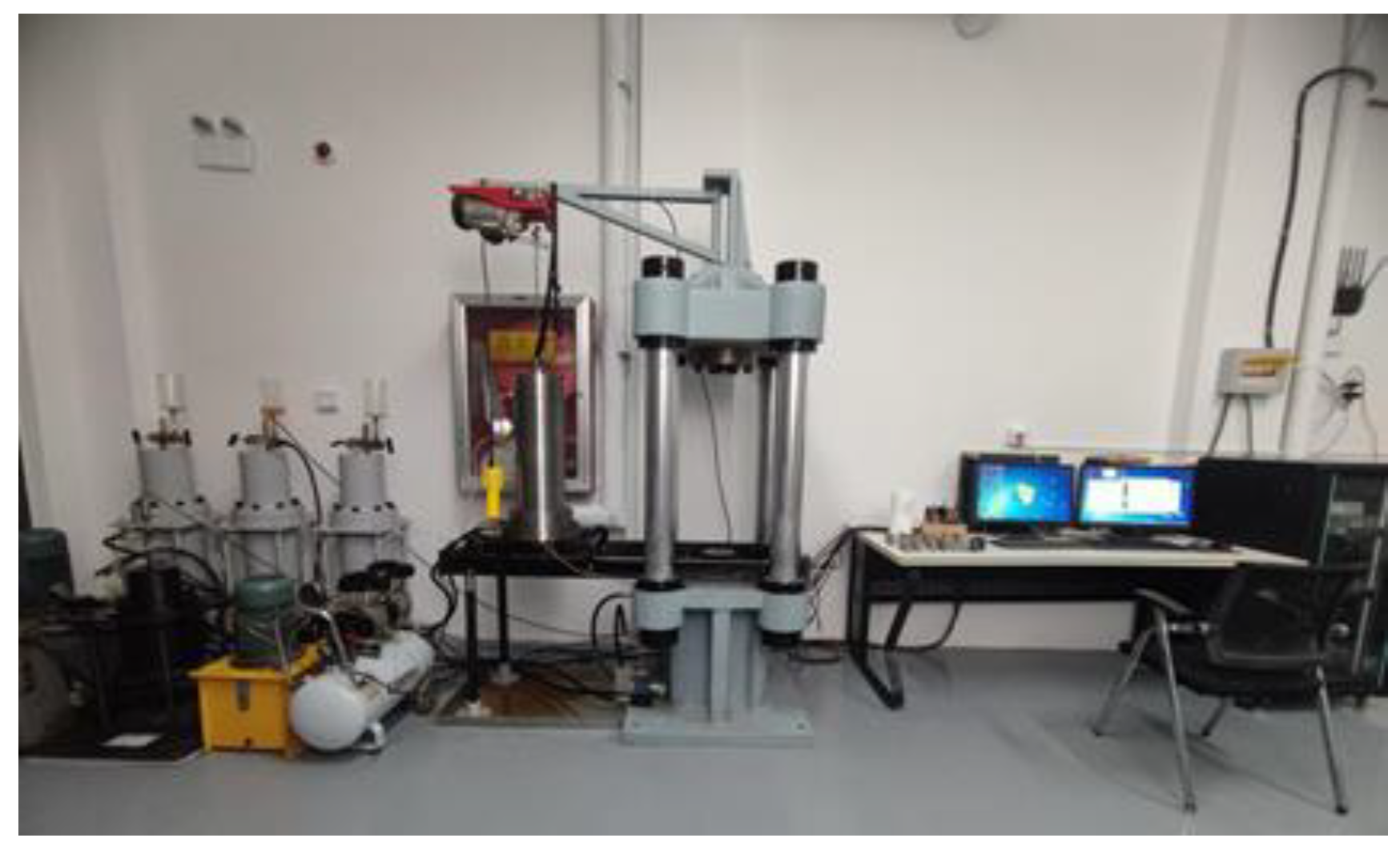


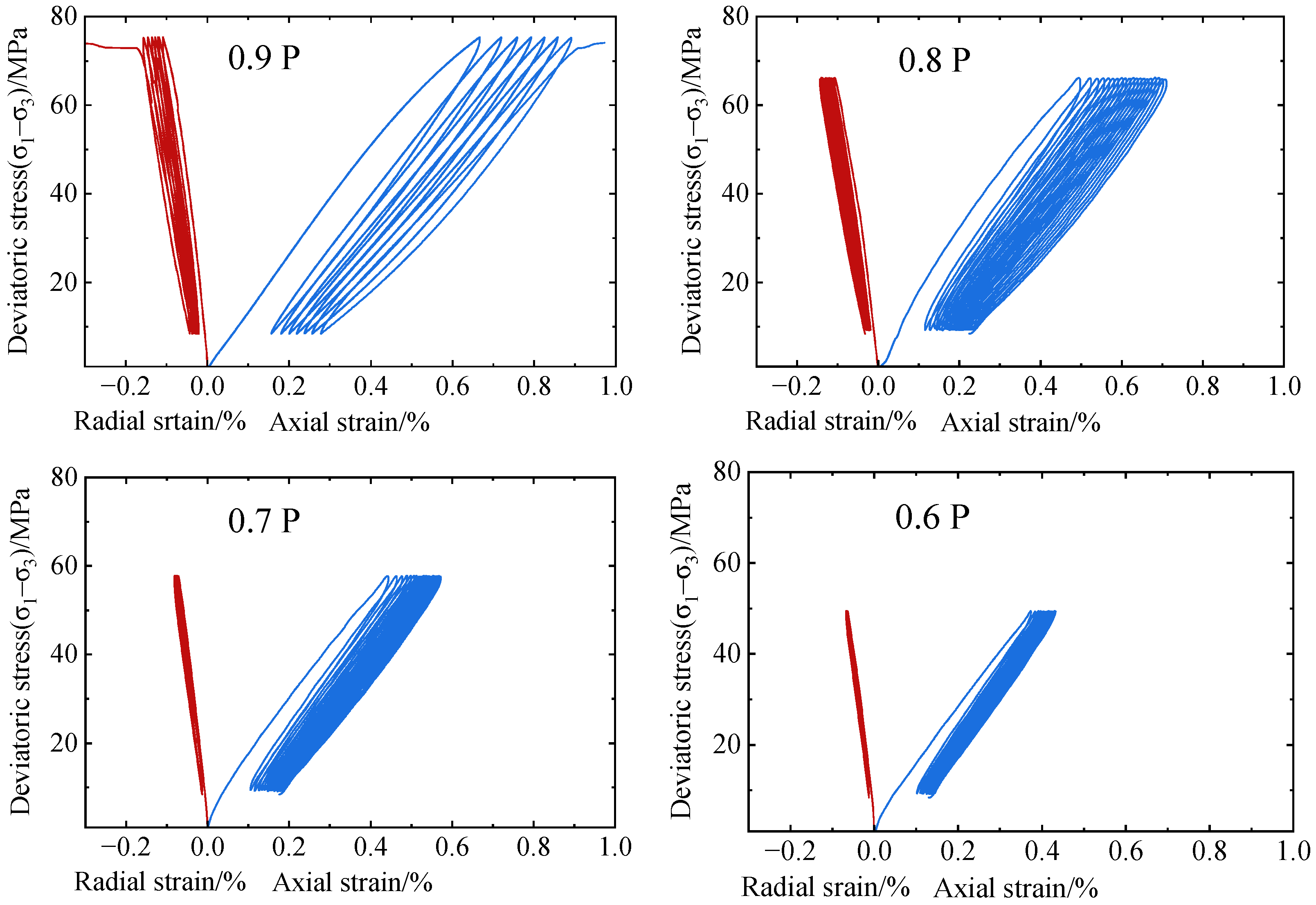

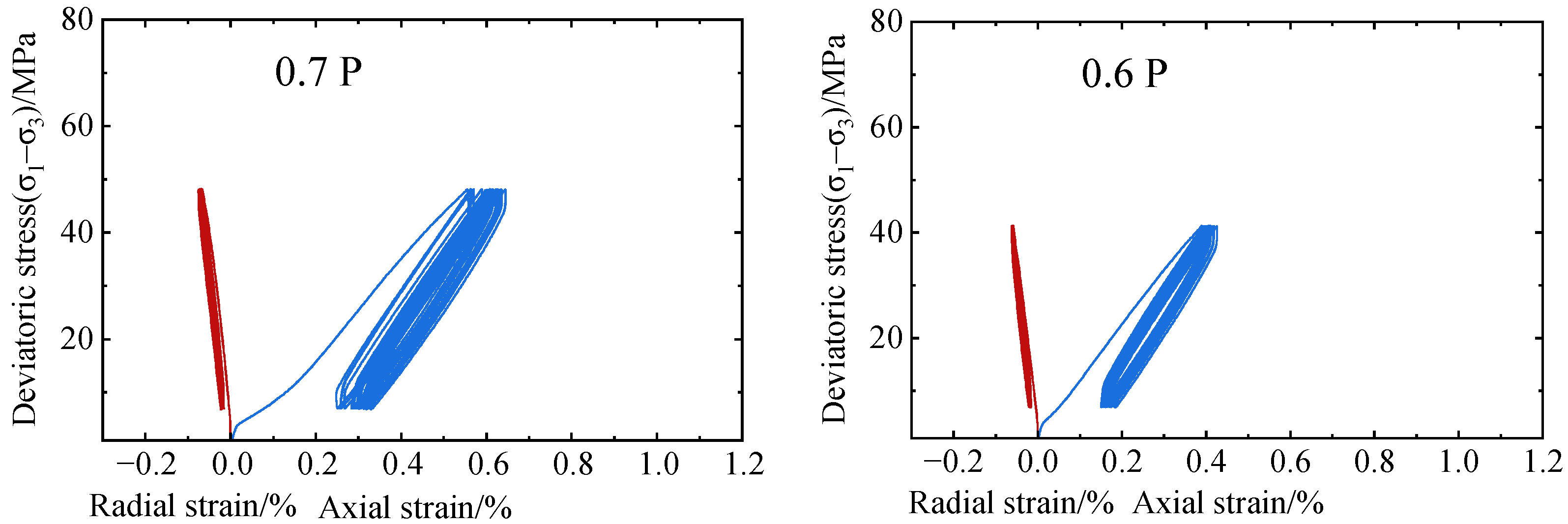
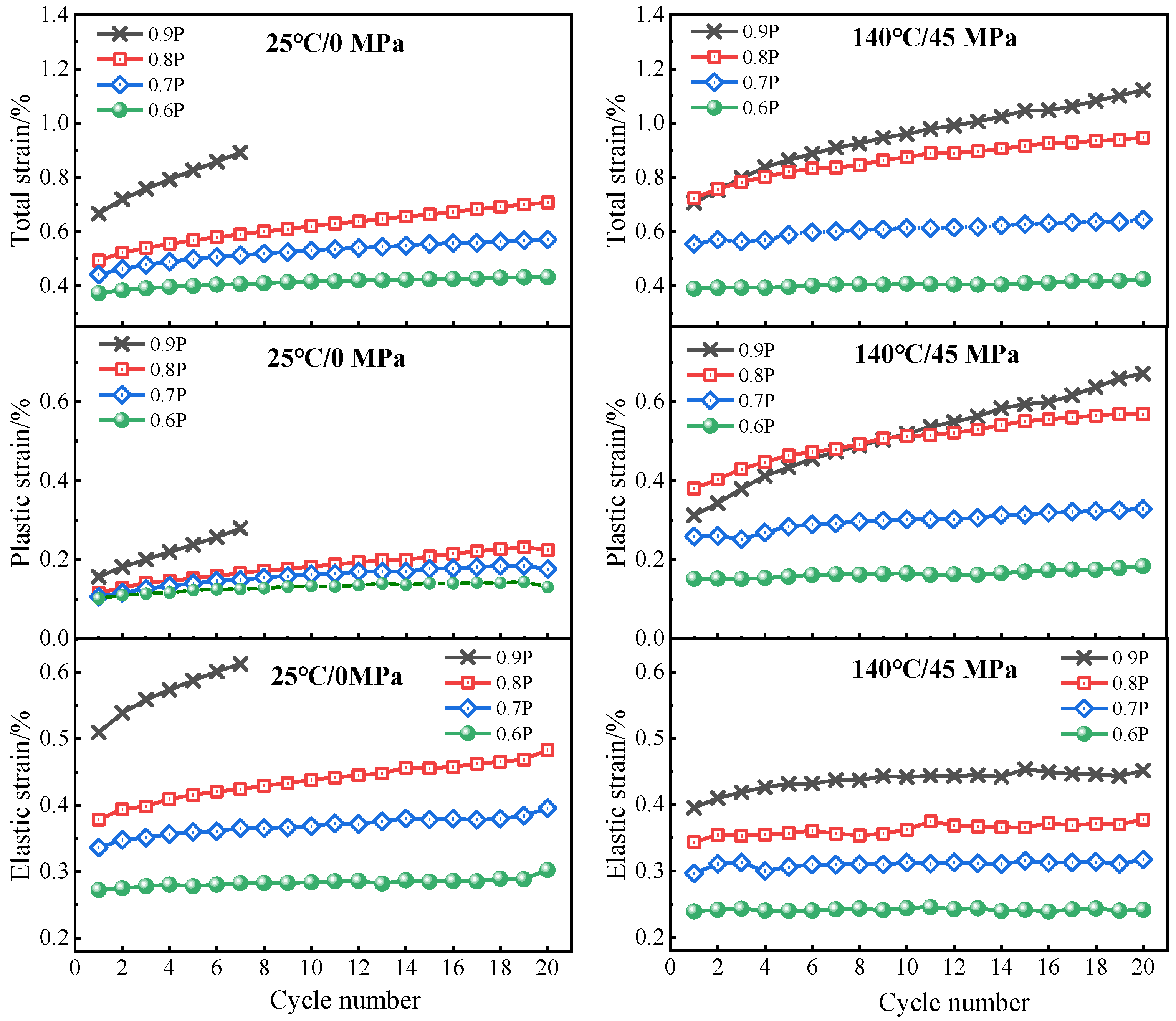
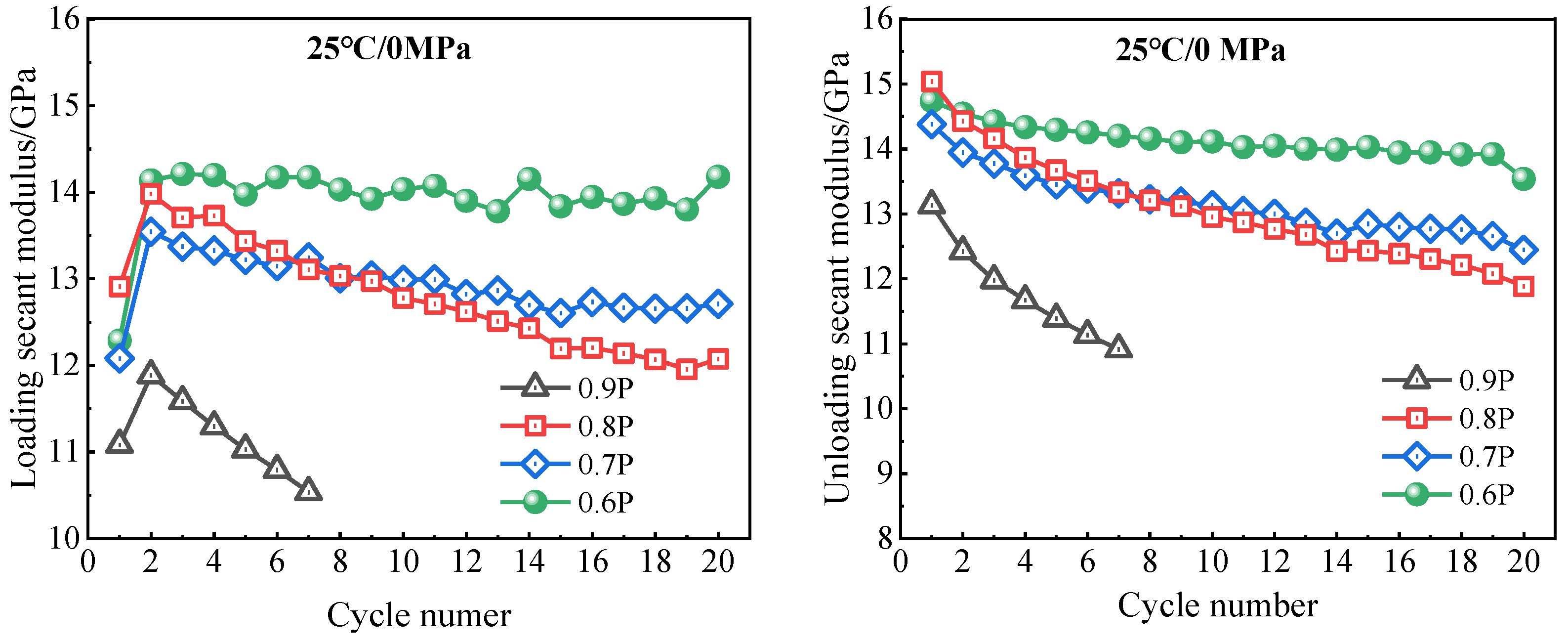
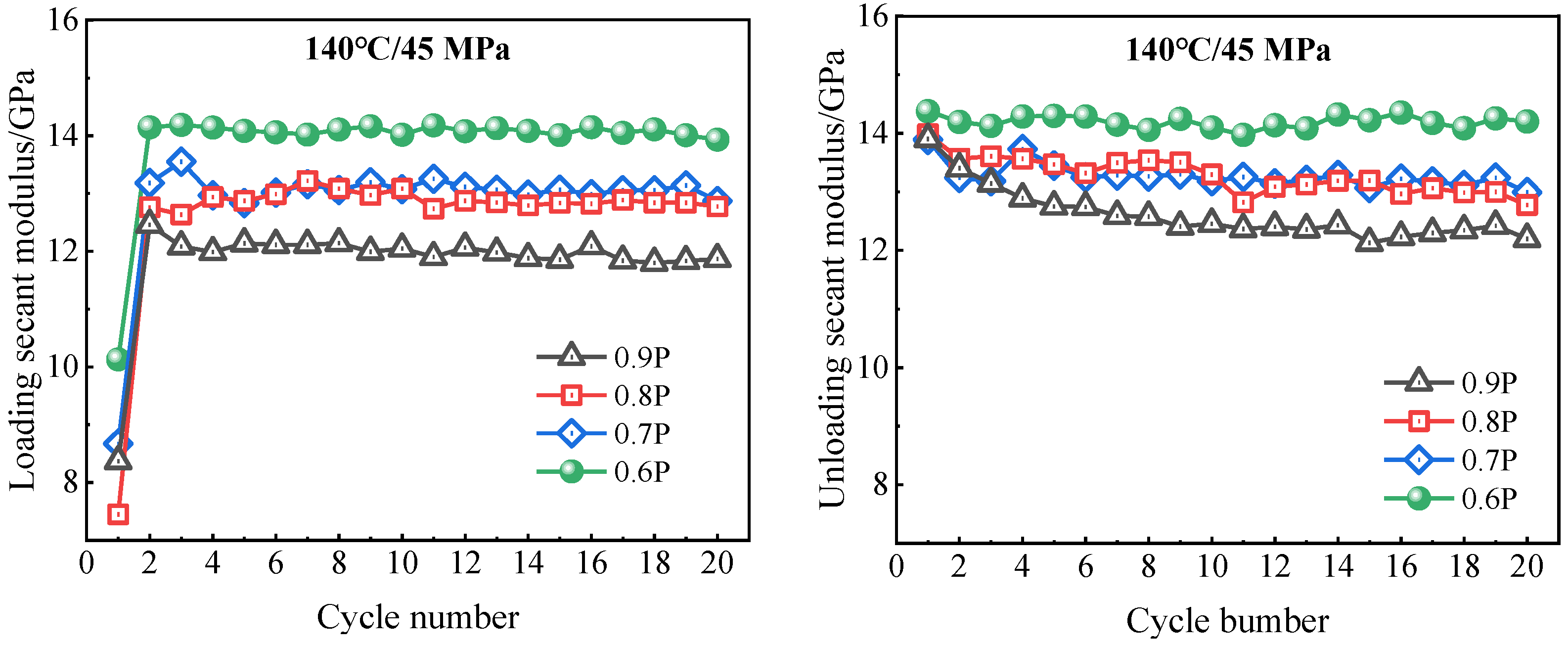

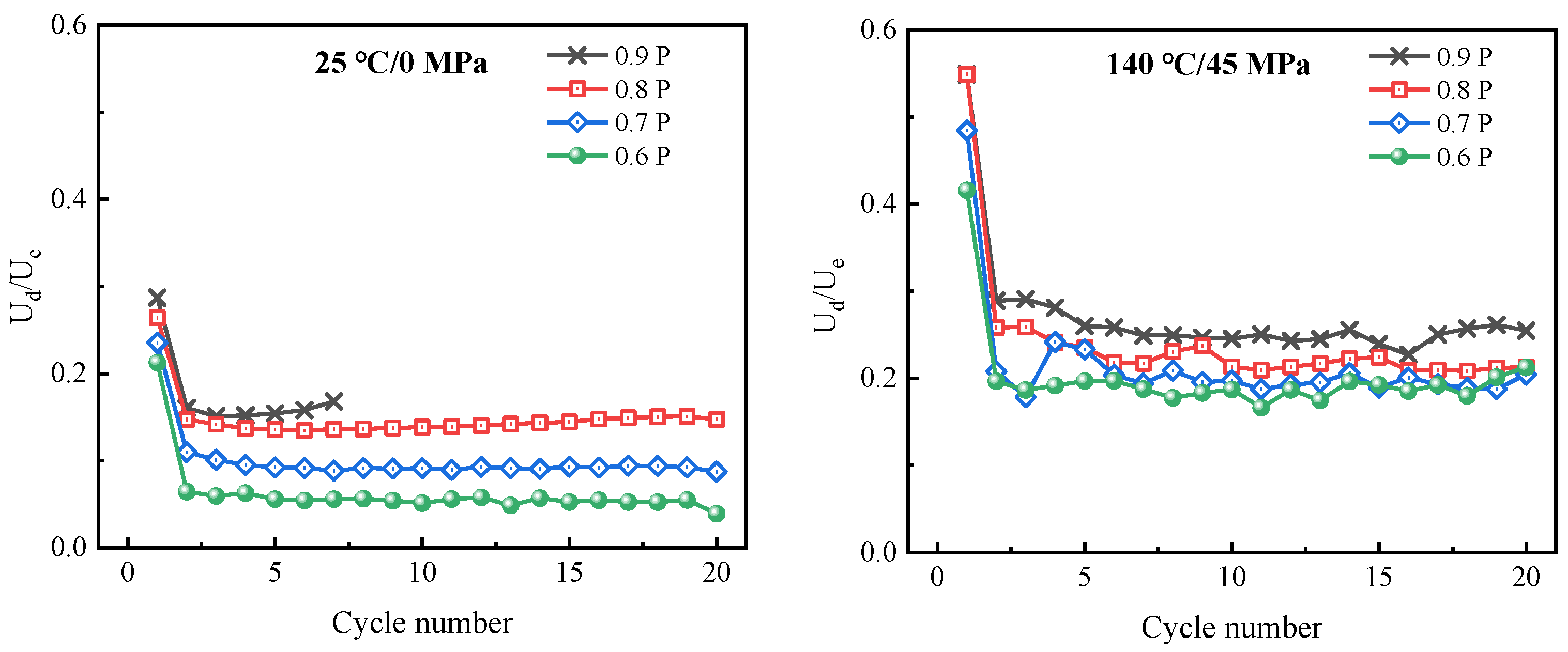

| Materials | Dosage (%bwoc) |
|---|---|
| Aksu cement | 100 |
| Anti-strength retrogression agent | 35 |
| Silica fume | 4 |
| Ductility-enhancement agent | 4 |
| Suspending agent | 1 |
| Dispersant | 1 |
| Water | 52 |
| Retarder | 3 |
| Fluid loss additive | 3.5 |
| Defoamer | 0.5 |
| Specimens | Testing Temperature/°C | Testing Pressure/MPa | Compressive Strength/MPa | Elastic Modulus/GPa | Poisson’ Ratio |
|---|---|---|---|---|---|
| M1 | 25 | 0 | 80.54 | 11.70 | 0.212 |
| M2 | 25 | 0 | 86.16 | 12.86 | 0.189 |
| M3 | 25 | 0 | 84.59 | 12.64 | 0.188 |
| Average | 83.73 ± 2.92 | 12.4 ± 0.62 | 0.19 ± 0.014 | ||
| M4 | 140 | 15 | 67.70 | 10.96 | 0.251 |
| M5 | 140 | 30 | 65.45 | 10.89 | 0.155 |
| M6 | 140 | 45 | 68.80 | 11.11 | 0.178 |
| M7 | 140 | 60 | 67.33 | 10.25 | 0.151 |
| M8 | 140 | 75 | 61.77 | 10.24 | 0.154 |
| Average | 66.21 ± 2.76 | 10.69 ± 0.41 | 0.178 ± 0.04 | ||
| Specimens | Intensity of Cyclic Loading | Testing Temperature/°C | Confining Pressure /MPa | Compressive Strength/MPa | Elastic Modulus/GPa |
|---|---|---|---|---|---|
| C2 | 80% | 25 | 0 | 77.97 | 9.89 |
| C3 | 70% | 25 | 0 | 83.93 | 11.31 |
| C4 | 60% | 25 | 0 | 81.53 | 12.67 |
| C5 | 90% | 100 | 45 | 69.07 | 9.83 |
| C6 | 80% | 100 | 45 | 67.05 | 10.56 |
| C7 | 70% | 100 | 45 | 66.18 | 10.96 |
| C8 | 60% | 100 | 45 | 62.51 | 11.69 |
| Samples | C1 | C2 | C3 | C4 |
|---|---|---|---|---|
| Maximum loading intensity | 90% | 80% | 70% | 60% |
| Loading rate/(N/s) | 100 | 100 | 100 | 100 |
| Loading frequency f/Hz | 0.00159 | 0.00181 | 0.00209 | 0.00251 |
| Loading period T/s | 629 | 553 | 478 | 398 |
| 0.149 | 0.149 | 0.149 | 0.149 | |
| 0.00196 | 0.00535 | 0.00215 | 0.00102 | |
| 10−5·s−1 | 3.12 | 0.967 | 0.450 | 0.256 |
| Fatigue life NF | 7.5 | 27 * | 68 * | - |
| Samples | C5 | C6 | C7 | C8 |
|---|---|---|---|---|
| Maximum loading intensity | 90% | 80% | 70% | 60% |
| Loading rate/(N/s) | 100 | 100 | 100 | 100 |
| Loading frequency (f/Hz) | 0.00193 | 0.00219 | 0.00257 | 0.00308 |
| Loading period (T/s) | 519 | 458 | 389 | 324 |
| 0.302 | 0.302 | 0.302 | 0.302 | |
| 0.0151 | 0.00540 | 0.00297 | - | |
| 10−5 s−1 | 2.890 | 1.179 | 0.763 | - |
| Fatigue life/NF | >20 | >56 * | >102 * | - |
Disclaimer/Publisher’s Note: The statements, opinions and data contained in all publications are solely those of the individual author(s) and contributor(s) and not of MDPI and/or the editor(s). MDPI and/or the editor(s) disclaim responsibility for any injury to people or property resulting from any ideas, methods, instructions or products referred to in the content. |
© 2024 by the authors. Licensee MDPI, Basel, Switzerland. This article is an open access article distributed under the terms and conditions of the Creative Commons Attribution (CC BY) license (https://creativecommons.org/licenses/by/4.0/).
Share and Cite
Zhang, Z.; Yuan, Z.; Ye, S.; Li, Y.; Yang, L.; Pang, X.; Lv, K.; Sun, J. The Influence of Cyclic Loading on the Mechanical Properties of Well Cement. Energies 2024, 17, 3856. https://doi.org/10.3390/en17153856
Zhang Z, Yuan Z, Ye S, Li Y, Yang L, Pang X, Lv K, Sun J. The Influence of Cyclic Loading on the Mechanical Properties of Well Cement. Energies. 2024; 17(15):3856. https://doi.org/10.3390/en17153856
Chicago/Turabian StyleZhang, Zhen, Zhongtao Yuan, Sutao Ye, Yang Li, Lvchao Yang, Xueyu Pang, Kaihe Lv, and Jinsheng Sun. 2024. "The Influence of Cyclic Loading on the Mechanical Properties of Well Cement" Energies 17, no. 15: 3856. https://doi.org/10.3390/en17153856





